The demand for intercity bus and rail travel options is on the rise in the National Capital Region. With Union Station in the District of Columbia serving as a hub for connections to the Northeast Corridor and points south and west, transportation providers and state agencies are working together to meet the needs of travelers with intercity service options that are economically and environmentally sound.
On October 18, the Transportation Planning Board (TPB) invited representatives from Amtrak, Union Station Redevelopment Corporation (USRC), American Bus Association (ABA), Maryland Department of Transportation- Maryland Transit Administration (MTA), and the Virginia Passenger Rail Authority (VPRA) to an Intercity Rail and Bus Travel Work Session. The session was an opportunity to hear how travel has evolved since the coronavirus pandemic and learn about the transformational changes underway for all intercity modes.
In the coming years, passengers traveling through the region will benefit from the Long Bridge connection between the District of Columbia and Virginia, additional rail service in Maryland, more curbside bus options from regional pick-up points, and a revitalized Union Station that will preserve the architectural significance of the building while improving travelers’ experiences and fully integrating bus facilities into the existing rail hub.
HIGHLIGHTS
Virginia
DJ Stadtler, CEO of VPRA, shared news on Transforming Rail in Virginia, an initiative that will expand rail services in the commonwealth. Virginia’s passenger rail network includes a mix of state-supported Amtrak routes, long-distance Amtrak trains, a North Carolina-supported rail route, and two Virginia Railway Express (VRE) lines. Amtrak ridership in Virginia is exceeding expectations. In the first three quarters of 2023, state-supported trains served over 848,000 passengers.
The Long Bridge project is the tie that binds improvements on both sides of the Potomac. Two new tracks crossing the river, paralleled by a new bicycle and pedestrian bridge, are planned to ease delays and increase passenger rail capacity. The addition of track between Quantico and the District, a rail bypass near Franconia in Northern Virginia, addition of a fourth track in Alexandria, and reconstruction of the Crystal City platform will result in new Amtrak and VRE daily roundtrips and improved passenger connections to Reagan National Airport.
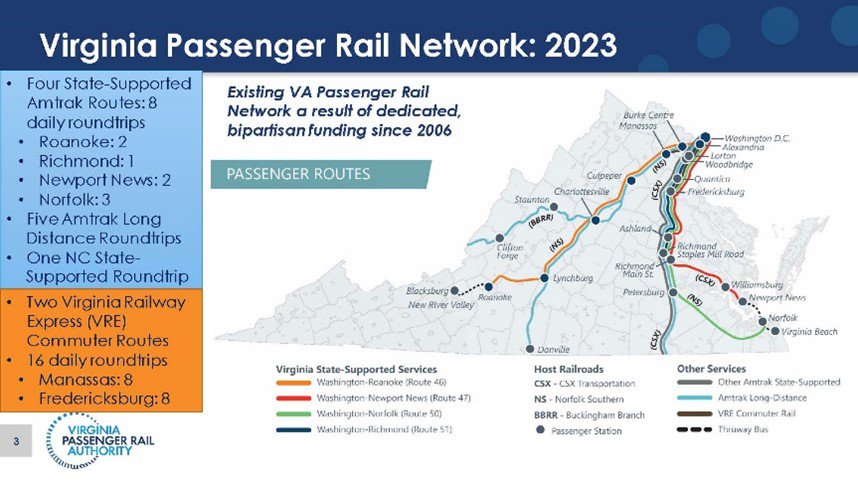
(VPRA)
Maryland
Maryland provides state support for private bus providers and MARC train services. Currently, Greyhound and BayRunner are the key intercity bus operators. Travis Johnston, MTA Director of Local Transit Support, noted that BayRunner provides service west to Grantsville and from BWI Airport to Ocean City, as well as Amtrak Thruway bus-service. Greyhound serves customers between DC and Wilmington, Delaware, north-south from New York to Norfolk, Virginia, and west toward Hagerstown, Maryland.
MTA is currently exploring MARC expansion through a Brunswick Line Study and the MARC Growth and Transformation Plan. The Brunswick study is complete and includes findings related to potential service expansion in western Maryland. Next steps are a Silver Spring turnback feasibility study to provide additional service west of Silver Spring and a redesign of the Point of Rocks/Frederick platform.
In addition to the Brunswick Line Study, MTA is updating its 2019 long-range plan with the MARC Growth & Transportation Plan. The planning process is underway, and as part of its long-range considerations, MTA will explore expansion in three directions—through-service to Alexandra, Virginia, along the Brunswick Line to western Maryland, and weekend service to Delaware, including a new station at Elkton. The planning process kicked off with a public survey on defining the vision and goals for the MARC train system. (A link to the survey is available on the plan webpage.) From there, market analysis, capital planning, and implementation strategy work will take place through Summer 2024.
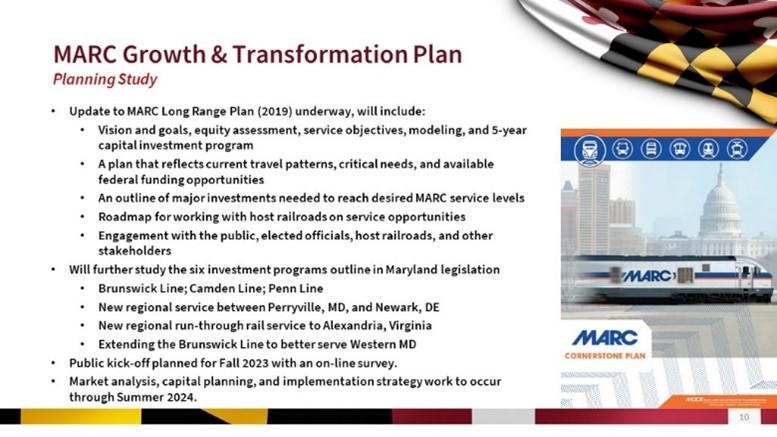
(MTA)
American Bus Association
Brandon Buchanan, Director of Regulatory Affairs at ABA, reported that nationwide the intercity bus industry has 30,000 coaches in service that provide 530 million customer trips per year. Intercity service is defined by both an interconnected network of terminal-based and curbside-based services as well as express point-to-point service. Most routes are in the Northeast, along the coasts, Midwest around Chicago and the Great Lakes, Southwest, and a section of the Southeast.
As Buchanan noted, intercity bus is the one mode that connects to all other modes. This means connections to Amtrak, Metro, MARC, and VRE as well as airports, cruise ship ports, and military installations. Intercity bus is ever evolving and an economic driver for the region in that passengers typically spend four to five days in a location, on average spend $92 per day, and that Union Station receives $33 million per year in retail spending from intercity bus travelers. In line with the TPB’s priorities, intercity bus mitigates congestion and is a sustainable travel opportunity, particularly for younger riders under the age of 35 who make up 73 percent of intercity ridership.
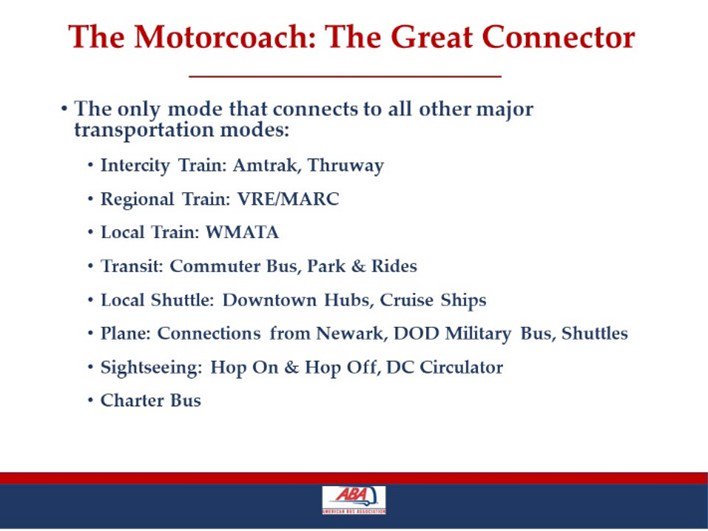
(ABA)
Amtrak
Jeffrey Ensor, Senior Director of Portfolio Management for Amtrak’s Northeast Corridor South End, announced that Amtrak’s Northeast Regional and Acela trains surpassed pre-coronavirus pandemic levels in FY 2023 with over 9 million customer trips on the Northeast Corridor, and Acela had approximately 3 million customer trips in FY 2023—both services having significant demand on Fridays and Sundays. Amtrak is dedicated to doubling ridership by 2040, and with environment and resilience in mind, plans to operate on carbon-free electricity by 2045. Solar energy will be incorporated into Baltimore’s Frederick Douglass tunnel modernization as well as into the Washington, DC, Ivy City maintenance yard.
Amtrak is investing in station improvements. For example, in Crystal City customers will be able to exit the station and walk to Reagan National Airport. Other investments include fleet upgrades, rail infrastructure updates for state of good repair, and track replacement. Ensor encouraged TPB members to help spread awareness of Amtrak through local communications and to fund infrastructure investments to improve pedestrian access to stations and pick-up and drop-off locations. Ensor also requested that members communicate with other elected officials and members of Congress about the importance of continued investments in Amtrak because there is currently not a passenger rail trust fund.
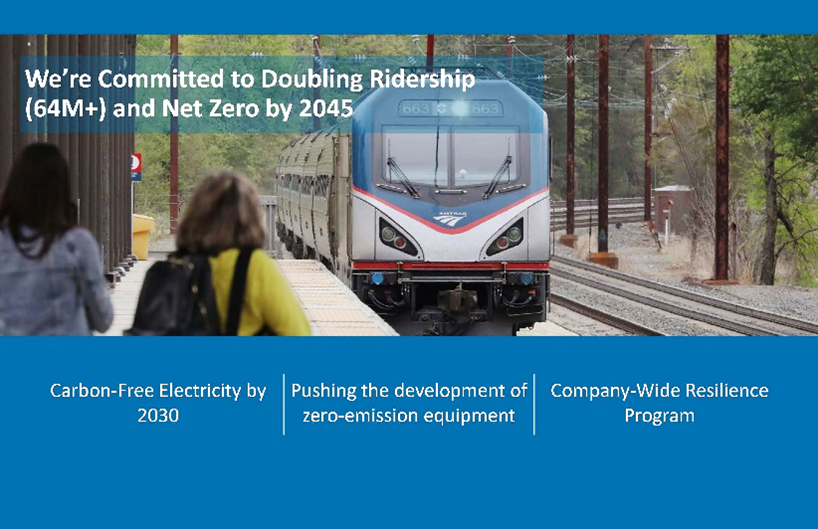
(Amtrak)
Union Station Redevelopment Corporation
Union Station serves as the region’s multimodal hub, and the USRC has the mission of preserving the station’s historic and architectural significance, maintaining the station’s role as a connecting point for rail, bus, and local transportation, and enhancing retail and amenities. Doug Carr, President & CEO of USRC, said that Union Station-related ridership is on the upswing after the pandemic. Between 2018 and 2022, the majority of Union Station-related ridership was almost evenly split between Metrorail and Amtrak. The station also serves MARC, VRE, intercity bus providers, and Metrobus.
A major focus of USRC is the Station Expansion Project, which will improve modal access and transfers through intentional integration of commuter and intercity services while protecting the historically significant architecture of the station. The design concept for Union Station is shown in the slide below.
Project design for a redeveloped Union Station will support operational needs and service expansion, bolster economic vitality in the region and integrate with surrounding neighborhoods. USRC considers the new design beneficial for planning through-route commuter trains, increasing train capacity, improving service reliability, and ultimately adding to the overall passenger experience.
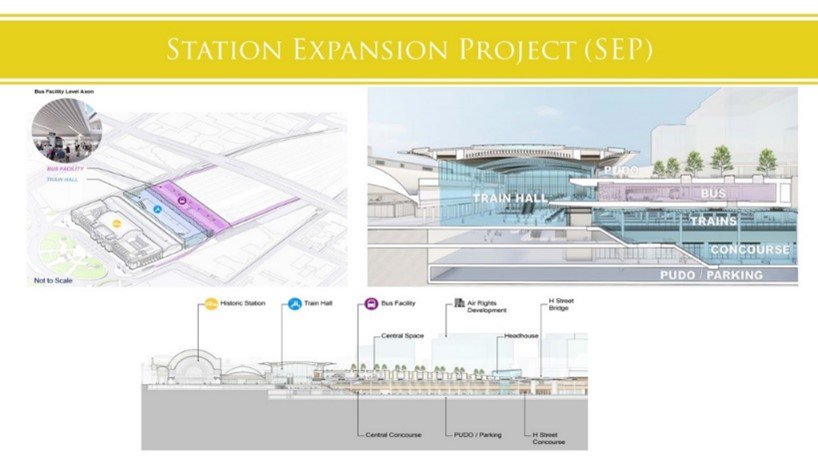
(USRC)
Q & A with Panel Members
Bridget Donnell Newton, Mayor of the City of Rockville, asked about potential impact to the city’s historic African American neighborhood if track expansion occurs on the Brunswick Line. MTA staff responded that MTA will look at historic impacts as part of the study. Dean Del Peschio, MARC Chief Strategy Officer, said that passenger and freight rail will still need to share traffic along the Brunswick Line.
David Edmondson, City of Frederick Planning Department, asked whether consideration has been given by MTA to expanding capacity south of Silver Spring. Del Peschio commented that infrastructure capacity is constrained south of Silver Spring, and expansion would be difficult.
Takis Karantonis, Arlington County Board Member, asked if Amtrak has a goal of how many passengers it would like to carry in regard to mode shift to rail for intercity trips. Ensor said that Amtrak’s goal is to double ridership by 2040 which will require additional trains and changes in infrastructure. Ensor noted that rail has the larger mode share between Washington and New York versus highway driving, but road travel still has the largest mode share in the Northeast Corridor overall. Carr responded that the Union Station project is fundamentally about increased capacity and mode shift.
Key Takeaways for the Region’s Leaders
- Local, state, and federal investments are necessary to improve the infrastructure and customer experience at bus and rail facilities.
- TPB member communication about and outreach to policymakers about the need for intercity investments is critical to securing capital and operations funding.
- Improved access to stations through completed sidewalks, wayfinding, lighting, and safe crossings is an important aspect of supporting intercity travel.
- Promoting intercity bus and rail travel will support regional congestion, environmental, resilience, and safety goals.
Related TPB Activities and Resources
June 2023 Intercity Bus and Rail Travel Overview (Item 8 Presentation)
Intercity Bus Traffic and Patronage in the Metropolitan Washington Region
Thank you to the TPB’s Intercity Travel Work Session expert panelists.
DJ Stadtler, CEO
Virginia Passenger Rail Authority
Travis Johnston, Director of Local Transit Support
Maryland DOT- Maryland Transit Administration
Dean Del Peschio, Chief Strategy Officer
MARC
Brandon Buchanan, Director of Regulatory Affairs
American Bus Association
Jeffrey Ensor, Senior Director of Portfolio Management
Northeast Corridor South End, Amtrak
Doug Carr, President & CEO
Union Station Redevelopment Corporation